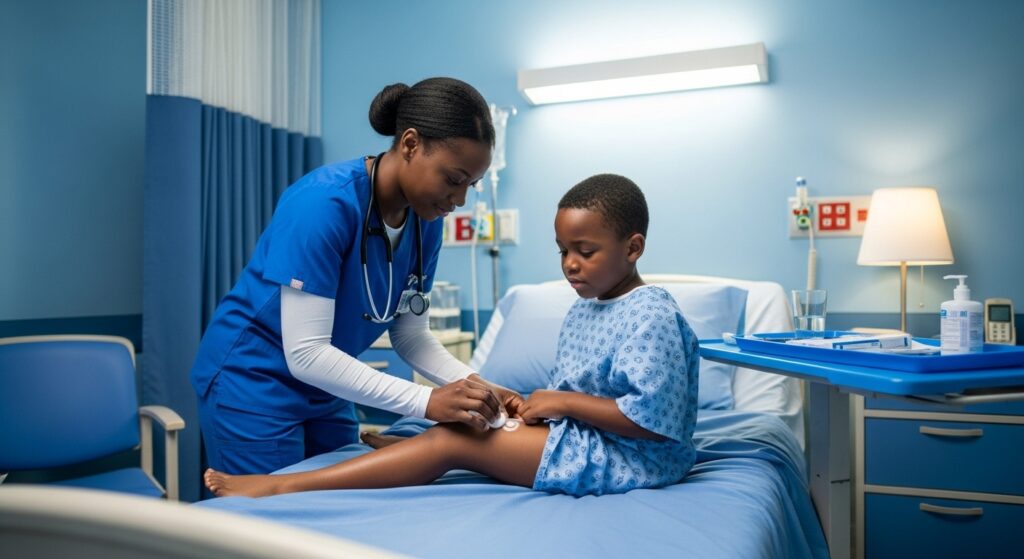
Soft tissue infections in children are often treated as isolated complications, but in Chad they have emerged as a pressing public health concern. A recent study conducted at the Mother and Child University Hospital Center in N’Djamena reveals the scale of the problem and the human stories behind the statistics. The study notes that “soft tissue infections secondary to parenteral injection frequently arise due to inadequate adherence to aseptic protocols during medical care administration.” This simple observation captures the essence of a crisis that is both preventable and devastating.
Over a twelve-month period, researchers documented thirty-seven pediatric patients admitted with soft tissue infections following parenteral injection. These cases represented 28 percent of all admissions for soft tissue infections in the pediatric surgery department. The numbers alone are striking, but the details are even more telling. The majority of affected children were between one and five years old, with a mean age of 5.6 years.
Injections were most commonly administered as part of malaria treatment, and artemether was implicated in more than half of the cases. The buttock was the most frequent site of injection, followed closely by the thigh. The study explains that “infections were attributed to home-based care in 37.8% of cases, and nurses were responsible for administering injections in 42.3% of cases.” These figures highlight the complex interplay of professional practice, informal care, and community reliance on injectable treatments.
The clinical picture was grim. Pain was the predominant symptom, reported in nearly three-quarters of cases. The interval between injection and hospital admission was often prolonged, with more than a third of patients presenting between two and four weeks after the initial injection. This delay in seeking care contributed to the severity of infections. Abscess formation was observed in 70 percent of cases, and Staphylococcus aureus was isolated in the same proportion of samples.
The study emphasizes that “management was primarily based on surgical drainage and empirical antibiotic therapy,” a reminder that once infections take hold, treatment is invasive and resource-intensive. Anemia was detected in two-thirds of patients, compounding the burden of disease. While outcomes were favorable in 95 percent of cases, the mortality rate of 5 percent is sobering, especially given that these deaths were linked to septic shock and anemia.

The study situates these findings within a broader regional and global context. Similar research in the Central African Republic reported comparable frequencies of post injection infections, suggesting that this is not an isolated phenomenon but part of a wider pattern in sub Saharan Africa. Both home-based care and care provided in health centers contribute to the incidence of soft tissue infections, reflecting systemic challenges.
Inadequate aseptic technique, reliance on street drug vendors, and community preferences for injectable treatments all converge to create conditions ripe for infection. Malaria, the most common indication for injections, further amplifies the risk, as families often seek rapid relief through injectable medications even when oral alternatives might suffice.
The human dimension of these infections cannot be overlooked. Families frequently turn to traditional treatments before seeking hospital care, with 37.8 percent of patients in the study having received such remedies prior to admission. This reliance on traditional practices is shaped by poverty, limited access to healthcare, and cultural beliefs. The delay in consultation, often spanning weeks, reflects both structural barriers and parental hesitation. The study notes that “post injection soft tissue infections are frequently observed in patients with underlying malnutrition and sickle cell disease,” conditions that weaken resilience and complicate recovery. Each statistic represents a child in pain, a family in distress, and a healthcare system stretched to its limits.
The bacteriological profile of these infections is dominated by Staphylococcus aureus, a skin commensal that becomes pathogenic when aseptic procedures fail. The high prevalence of this organism is explained by the lack of proper sterilization during care. Surgical exploration was required in nearly three-quarters of cases, while debridement was performed in the remainder.
These interventions are not only physically taxing for young patients but also costly for families and healthcare facilities. The study’s conclusion is clear: “strict adherence to aseptic procedures and improved training in injection techniques are essential to enhance patient outcomes.” This call to action resonates beyond Chad, serving as a reminder that basic infection control measures remain the cornerstone of safe medical practice.
The implications of this research extend to policy, practice, and community education. Training healthcare personnel in aseptic protocols is vital, but so too is addressing the informal sector where street drug vendors continue to provide injections without proper safeguards.
Public awareness campaigns could help shift community preferences away from unnecessary injectable treatments, particularly for uncomplicated malaria. Strengthening health infrastructure, ensuring access to clean water, and promoting oral alternatives where appropriate are all part of a comprehensive response. The study demonstrates that while outcomes can be favorable, the risks are real and the costs are high.
In reflecting on these findings, one is struck by the resilience of families and the dedication of healthcare workers in N’Djamena. Despite limited resources, they confront infections that are painful, dangerous, and often preventable. The mortality rate, though relatively low, represents lives that could have been saved through earlier intervention and stricter adherence to aseptic technique. The study’s authors remind us that “soft tissue infections secondary to parenteral injection remain a significant pediatric health concern.” This statement is not merely academic; it is a call to recognize the hidden burden carried by children and families in Chad and to act with urgency.
The story of post-injection soft tissue infections in Chad is ultimately a story of preventable suffering. It is about the intersection of poverty, tradition, and fragile health systems. It is about the need for training, awareness, and systemic reform. Most importantly, it is about children whose lives are disrupted by infections that should never have occurred. As the study concludes, ongoing training of healthcare personnel in aseptic protocols is a key strategy for reducing incidence. But beyond training, there must be a collective commitment to ensuring that every injection is safe, every child is protected, and every family has access to care that heals rather than harms.
In the words of the researchers, “clinical outcomes were favorable in 95% of cases, with a mortality rate of 5%.” Favorable outcomes are not enough when preventable deaths still occur. The challenge now is to transform these findings into action, so that the next generation of children in Chad can grow up free from the hidden burden of post-injection infections.



